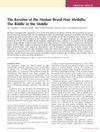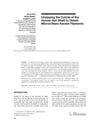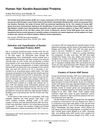TLDR Hair's molecular structure is mostly consistent, but genetic differences affect lipid types, which could help diagnose diseases.
The study investigated the molecular structure of human hair using high-resolution X-ray diffraction, focusing on differences between individuals, including genetic similarities. Despite a small sample size of 12 individuals, the research found that the general molecular features of hair, such as the coiled-coil phase of α-helical keratin proteins and lipid layers, were consistent across all samples. However, variations in lipid types were noted, suggesting genetic influence, as identical patterns appeared in hair from genetically similar individuals like identical twins and a father-daughter pair, but not in fraternal twins. These findings highlighted the potential of using hair's molecular structure as a diagnostic tool for diseases.
65 citations
,
May 2006 in “Journal of Structural Biology” Hair curliness is due to uneven distribution of different cortices within the hair fiber.
66 citations
,
June 2004 in “Biophysical Journal” 30 citations
,
July 2000 in “PubMed” Hair has unevenly distributed proteins and lipids, with lipids mainly in the cuticle and proteins in the cortex and medulla.
53 citations
,
September 1999 in “Journal of Synchrotron Radiation”
22 citations
,
January 2020 in “PeerJ” Keratin peptides in hair might help identify gender and ethnicity.
55 citations
,
January 2013 in “International Journal of Cosmetic Science” African hair's keratin structure is influenced by its higher lipid content.
 87 citations
,
July 2009 in “The journal of investigative dermatology/Journal of investigative dermatology”
87 citations
,
July 2009 in “The journal of investigative dermatology/Journal of investigative dermatology” Human beard hair medulla contains a unique and complex mix of keratins not found in other human tissues.
 7 citations
,
August 2006 in “Biopolymers”
7 citations
,
August 2006 in “Biopolymers” Researchers extracted tiny keratin filaments from human hair by unzipping its outer layer.
 71 citations
,
August 2005 in “The journal of investigative dermatology. Symposium proceedings/The Journal of investigative dermatology symposium proceedings”
71 citations
,
August 2005 in “The journal of investigative dermatology. Symposium proceedings/The Journal of investigative dermatology symposium proceedings” Hair keratin-associated proteins are essential for strong hair, with over 80 genes showing specific patterns and variations among people.
1 citations
,
August 1981 in “The Journal of Dermatology”



